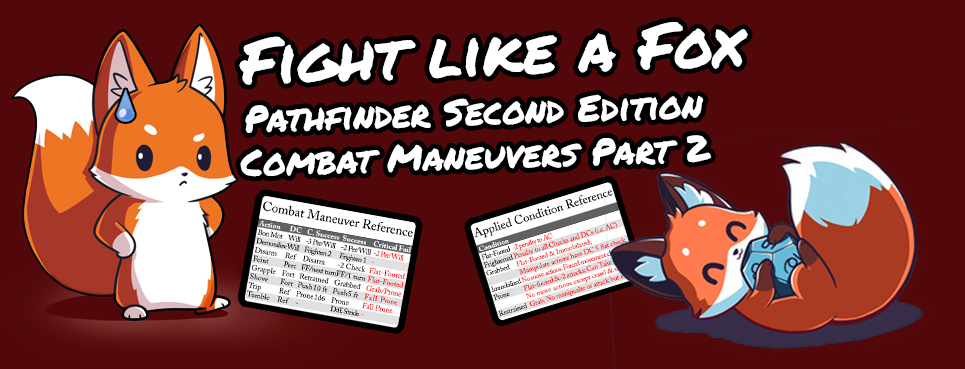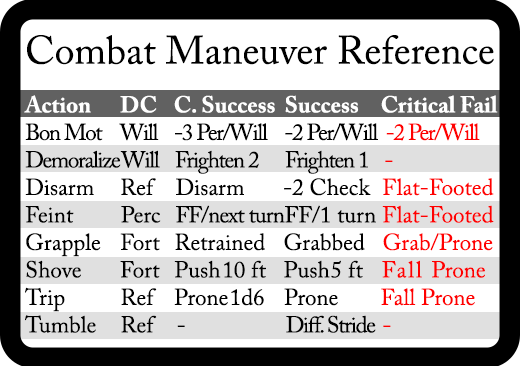Two weeks ago in “Fight Like a Fox, Part 1” I detailed the different varying combat maneuvers in Pathfinder 2e. Today I want to discuss more detailed strategy, including feats and abilities that really make them pop! To help summarize what we went over, I’ll go ahead and relink my combat maneuver card here at the top of the article so we don’t have to rehash the basics of each maneuver. But first, a spiel on metagaming and teamwork.
Teamwork and Metagaming
I want to save the bulk of this topic for its own article, but writing this I noticed the best thing about combat maneuvers is how much they play into party dynamics. And whether it’s tripping a flying enemy so the barbarian can reach it, or shoving an enemy into the range of a spell, there will come times when you might feel nervous about whether or not your excessive table-talk is “metagaming”. Now it’s up to each group (and each Game Master) to determine how much is too much when it comes to this. But I feel compelled to make the case that your characters are trained combatants who have lived, fought, trained, and practiced together on the field of battle in ways most players have never experienced. Humans have more than five senses, and intuition is said to play a bigger role during a life-and-death encounter than any game can accurately simulate. Sometimes it’s okay to have your barbarian think it’s a good idea to shove that goblin toward the wizard, even if their character doesn’t know the exact dimensions of the wizard’s burning hands. That sort of teamwork is built into the system to help players overcome challenges, and is key to making combat maneuvers relevant and encounters more engaging than a series of attack rolls.
Bon Mot
Bon mot is different from any other combat maneuver. It requires a skill feat and does nothing by itself to lower an enemy’s offensive combat efficacy. It’s the premiere ability of the Wit swashbuckler style. But the only abilities Swashbuckler gets are intended for the battledancer, who should consider investing in the skill. But Bon Mot is not exclusive to the Swashbuckler! In fact, I’d argue Bon Mot is best paired with a spellcaster who is targeting Will DCs, such as a Bard, Cleric, Oracle, Sorcerer, Wizard, or Witch. That doesn’t make it bad for a swashbuckler; On the contrary, it helps facilitate teamwork! But a spellcaster can make great use of it themselves, especially since so many of their spells are two actions.
Demoralize
Intimidation is one of the most stacked skills in Pathfinder 2e for martial characters. The penalty lowers attack and defense, increasing the efficacy of all player characters regardless of combat style. It has some of the best skill feats in the game. You can pick up a bonus from your strength, pick up an extra bonus against spellcasters, get a free intimidate check when you roll initiative, send opponent’s fleeing, or even kill them outright. These abilities play well together, letting you potentially take an opponent out of combat for the first round while rolling initiative. (Although Scare to Death is its own action, so it won’t function with feats that let you use intimidation as a free action, reaction, or part of another action.)
Almost every martial class gets further bonuses against frightening creatures. The Braggart Swashbuckler has a couple of feats to improve their fear, and can remove temporary immunity which can let you inflict all these conditions twice during the same encounter. Fighters can make them flat-footed with Shatter Defenses, or get bonuses to damage with Fearsome Brute. Rogues with Brutal Beating treat them as flat-footed. And Monk’s get to Intimidate and Attack for bonus damage with Gorilla Pound. Hobgoblins get the incredibly fun Agonizing Rebuke, letting you damage opponents with a skill check!
Many abilities can prevent a creature from lowering its Frightened condition, potentially causing abilities like Agonizing Rebuke to last longer. This includes the fighter’s Shatter Defenses, Swashbuckler’s Antagonize, Martial Artist’s Dragon Roar, and the summon-eligible Scarecrow. Hobgoblins can even lock someone into the condition with Remorseless Lash.
You can improve your check with the Demon Mask, Gorget of the Primal Roar, or Mask of the Banshee, and if you are against a higher level opponent I recommend activating your Grim Trophy talisman to try to overcome the difference in power. Eventually, you can save up for a Dread Blindfold, but expect at least one person at the table to keep repeating “you are not prepared!”
Disarm
Disarm is one of the most underrated maneuvers in 2e. Yes, it’s only effective against creatures that use weapons. Which in most campaigns is roughly the same percentage of creatures affected by all the various traits in Intimidation. And, yes, it requires a critical hit to “disarm”. But you have to remember that a critical success here is going to mean you’ve probably just eliminated an enemy’s offensive capabilities… assuming you or an ally have the extra action to pick up the weapon before your opponent.
The success condition of Disarm requires some effort to make effective. The -2 penalty is good, but it goes away at the start of the opponent’s turn so theoretically, it will only impede reactions (unless you are a swashbuckler or using an oily button). So you are either left readying an action to disarm when the opponent attempts to attack or picking up one of several feats that let you attempt to disarm an opponent when they attack you (such as the Bastion’s Disarming Block, Aldori Duelist’s Aldori Riposte, Duelist/Fighter’s Dueling Riposte, Fighter’s Twin Riposte, or Barbarian’s Embrace the Pain. Fighters can use Disarming Twist and Barbarians can use Disarming Assault to get a free Disarm attempt when they land an attack. And Ifrit get Scorching Disarm, which lets you deal damage to a target once per day when you succeed at a Disarm attempt (unless they drop their weapon).
Feint
Feint gets overlooked in 2e with how many other ways there are to make an opponent flat-footed, such as flanking or tripping. It only counts your next attack, (unless you are a Scoundrel Rogue). Fencer and Goading Feint aren’t the most exciting options for a swashbuckler, but they can multi-class to pick up some more feint tricks and, unlike Scare to Death, Goading Feint looks like it functions with abilities that give you a free Feint attempt. The afforemented rogue is going to be your go-to class for feinting, penalizing Reflex saves with Distracting Feint to help set up spells or other combat maneuvers, and debuffing the opponent even further with Overextending Feint and Deny Support. Rogues can also feint from far away with Ricochet Feint. Monks can feint for free during a flurry of blows with Stumbling Feint. And Scouts can use Scout’s Charge to move, feint and strike for two actions using Stealth instead of Deception. The highest level feint feat is the iconic Red Mantis Assassin’s Prayer Attack, which adds 2d6 bleed damage in addition to locking in a ranged feint turn after turn! Ancestry options include the Kobold’s hilarious Grovel feat, letting them feint at a range, and Gnomes can use Vibrant Display to Feint against all adjacent creatures once every 10 minutes instead of just one creature within reach.
Grapple
Formerly the king of combat maneuvers, grapple remains a powerful option in 2e! While it does give the opponent a baked-in way to eliminate the condition, it still takes up an action! There are three classes that can best take advantage of the combat maneuver: Barbarians, Fighters, and Monks. Barbarians get free damage with Brutal Bully. Then more free damage with Thrash (that later hits their friends with Collateral Thrash). Barbarisn can initiate grapples as a reaction with Embrace the Pain, as part of an attack with Furious Grab, or without even needing the athletics check using Impaling Thrust (and get a bonus with Furious Bully). Fighters can grapple as part of an attack using Combat Grab, and then stun using Dazing Blow (which you can read about in detail here). Monks can get bonus damage with Crushing Grab, use Mixed Maneuver to combine the grapple with other maneuvers, use Whirling Throw to toss a grappled opponent, or knock them out with Sleeper Hold. A dedicated grappler can take the Rain of Embers Stance which lets them eventually grab and cause an enemy to detonate in an Explosive Death Drop! Monks can also grapple as a reaction with Tangle of Battle.
If you want to use an archetype look no further than Hellknights, who can use the lesser benefit from the Order of the Chain to attack and grapple with a flail without having to worry about multiple attack penalty (without the disadvantages of using Assurance). Bounty Hunters can use Opportunistic Grapple when an enemy misses them. And Provocators can use Pin to the Spot to restrain a target without having to roll an Athletics check! In early levels I recommend looking into a Net if you want a way to grapple creatures up to 10 feet away from you, but the set DC check means it’s not as useful at higher tiers.
Shove
Shove is one of the most useful combat maneuvers in the game. It can be used to push enemies into hazardous terrain, negative effects, or just eat up their actions moving back into melee range. Fighters can use Aggressive Block to shove when they Shield Block or Brutish Shove to shove when they hit with a two-handed weapon. They Shove foes even further with Flinging Shove and doing bonus damage with Powerful Shove. Barbarians can effectively Shove without having to roll an Athletics check using Knockback, later tripping them for free with Awesome Blow, Shove three enemies using Unblaancing Sweep, and racking up free damage using Brutal Bully. If you love the idea of eating up an enemy’s actions with a Shove-Trip combo, check out the Rogue’s Stay Down reaction. Meanwhile the monk is pushing people further with Improved Knockback, or abusing the action economy/ignoring MAP with Mixed Maneuver, Flurry of Maneuvers, and Knockback Strike.
The Mauler Archetype lets you shove up to five creatures and Stride for 2 actions using Clear the Way, or Shove a creature leaving a square within your reach using Shoving Sweep, potentially costing it too much movement to reach an ally, or knocking it off the slide of a cliff. The Staff Acrobat can Shove using its quarterstaff, getting bonuses using Shove with Levering Strike, using Shove against two enemies at once with Staff Sweep, and doing bonus damage when you Leap, Strike, and Shove using Pivot Strike. The new Azarketi ancestry can even let you Shove u to 15 feet away using Hydraulic Maneuver, potentially knocking ranged enemies off their precarious sniping positions.
Trip
Have I repeated enough that you can Trip flying creatures? I just love that melee characters can do more with those readied attacks against lower-level flying enemies who seem to love flyby attacks. You can even use an aklys or bola to ranged trip! There are many feats that help you trip, and I highly recommend reading the Shove section since most of those feats either work with trip, or let you trip as a free action and won’t be repeated here for the sake of brevity. Even without any of these feats, Trip is a potent combat maneuver for making a foe unable to easily move without spending an additional action, and giving them the flat-footed condition!
Fighters can use Knockdown to ignore MAP and Improved Knockdown to just auto-crit your Trip attempt. In addition to getting a free Trip when they Shove using Stay Down, a Rogue gets bonus damage using The Harder They Fall (which combines so well with Improved Knockdown). Monks automatically knock foes down using Wolf Drag. In addition to being Shoving experts, Maulers can Trip multiple foes using Hammer Quake. The king of teamwork, Marshals can trip the target of an ally’s attack using Topple Foe. And once per minute when an Acrobat uses Tumble Through with Tumbling Opportunist, it gets a free Trip attempt!
Tumble Through
You might get some raised eyebrows if you announce to the table that your character is built around the Tumble Through maneuver, but let me assure you it’s a valid and fun combat maneuver that lets you play an effective and highly mobile character who can help position themselves to assist the rest of the party, especially when it comes to fighting in tight corridors. Ever have that problem where multiple melee characters want to hit the same monster, but the dungeon tunnel is only 5 feet wide? Tumble past and set up that wonderful flank train! Right off the bat you’re going to just want to check out the Acrobat archetype, which specializes in running through enemy squares to make them flat-footed. Any Swashbuckler regardless of style can use Tumble Through to regain panache, and get +1 to using Tumble Through while they are in panache. They can roll twice and take the better using Derring-Do and their Vexing Tumble and Tumble Behind feats let them make foes flat-footed similar to the acrobat. Rogues can also pick up Tumble Behind, using the flat-footed condition in conjunction with their sneak attack. If you are looking for an ideal ancestry to scurry around the battlefield, Shoony get a bonus with Scamper Underfoot and can continue to move even if they critically fail their check so long as they have Tough Tumbler. If you are looking for a more common heritage, Goblins also get a bonus if they are especially Bouncy.








